People - Garnet Hertz (2016)
Format: Sculpture with custom electronics
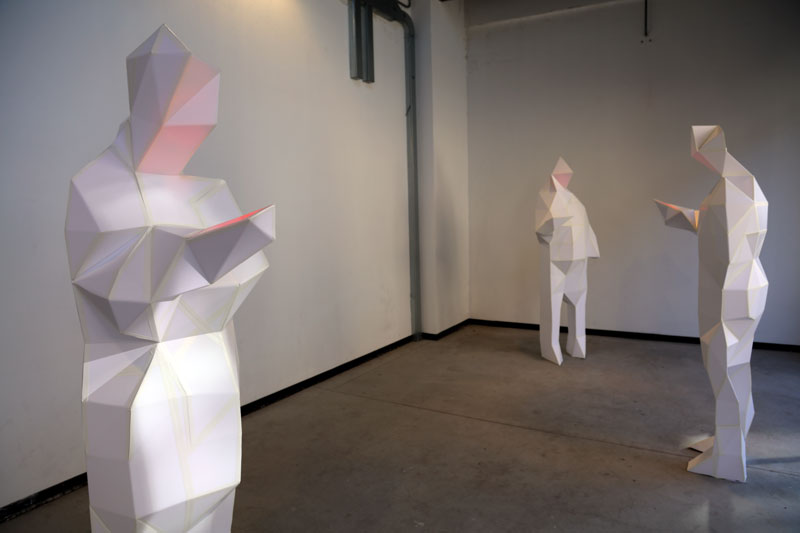
Description: This project, "People", examines the contemporary connection between individuals and their
mobile phones. The project focuses on individuals standing motionless in public space staring at
their smartphones, slowly caressing their screens, and proposes that these individuals are
almost a new type of hybrid life form. Our relationship with handheld technologies have created
a ubiquitous neo-cybernetic coupling between humans, technologies, and information systems
that shifts our status into something slightly alien.
From a practical standpoint, the project consists of three (3) to five (5) large low polygon human
figures, approximately 2 meters in height, that stand or sit motionless, staring at their hands as if
they were browsing a smartphone. Each figure resembles a life-sized white origami human, like
an angular George Segal plaster figure, with a hand that softly glows red like a slowly scrolling
screen or Tatsuo Miyajima LED piece. Most individuals looking at the figures assume they are
built out of sheet metal painted white.
This project was installed as a part of the XXI Triennale di Milano in
Summer 2016. During this installation, the piece was built in an open public studio, with festival goers able to watch the piece be constructed. The finished pieces were installed as short-term interventions throughout the city of Milan.

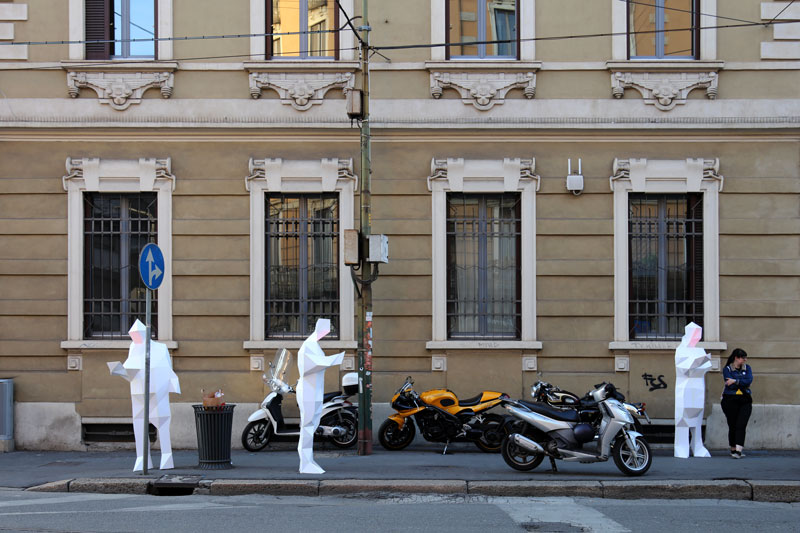
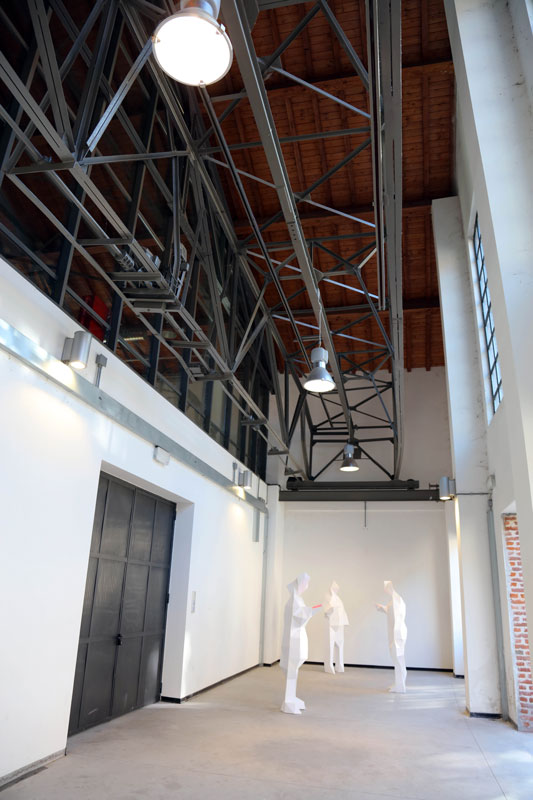
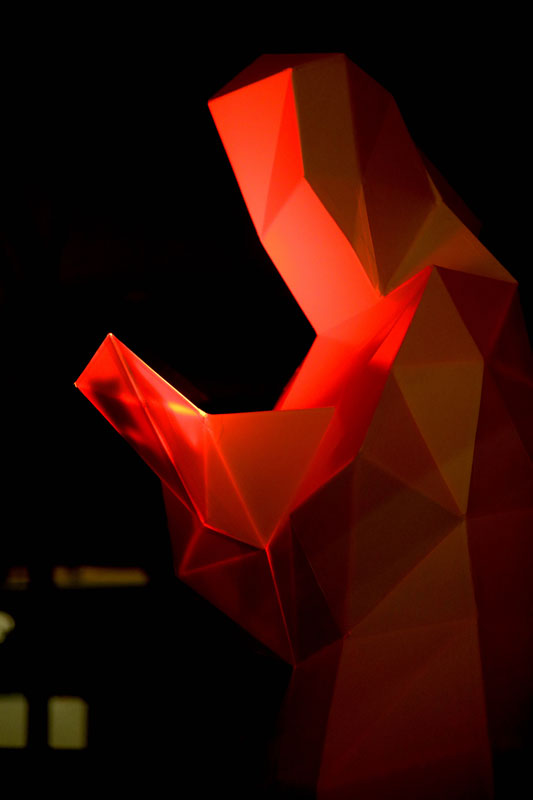
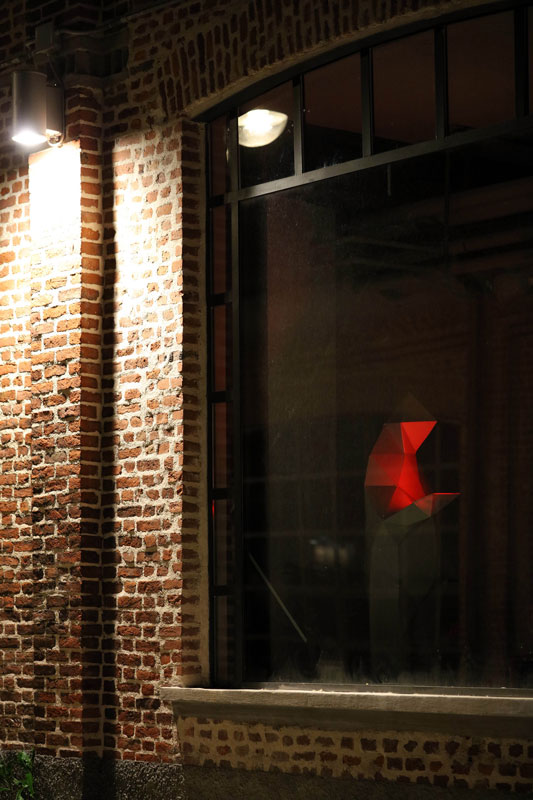
Project Development Process: The figures are based off of 3D laser scans of individuals holding cell phones, which are then
post-processed in 3D modelling software, unwrapped with specialized origami software, cut in
white foamcore or cardboard with a CNC drag knife, with the fragments carefully reassembled
on site with white tape. Each figure has a hand with a small Arduino and red LED matrices
inside, which sits behind a white plexiglass cover. Each figure has a USB port in one foot, and is
typically powered by a mobile phone charger - although for short term public interventions in
places like public parks, the sculptures can be illuminated with Lithium Polymer batteries.
People (1:1 Foamcore Test 1 - Max) from Garnet Hertz on Vimeo.
Exhibition Logistics: Because of their light weight (7kg each), transportability, and ability to be powered by
inexpensive LiPoly battery packs, the pieces can be installed in many different locations as a
public intervention. The project is also built out of low cost materials, which enables intervention
opportunities without needing to worry about damage to the pieces or retrieving them.
Logistically, the project ships as pre-cut flat sheets of foamcore or cardboard, and is assembled
on site. For pre-production on site, three large tables (approximately 1.0m x 2.4m) are required
for assembly. The duration of assembly and installation is approximately one day per figure, or 3
to 5 days, depending on the amount of figures desired. Each figure has a shipping volume of
approximately 1/2 a cubic meter with a weight of approximately 7kg. In other words, shipping
and installation options are as follows:
- Three (3) figures: 1.5 cubic meters (21kg) shipping, 3 days install.
- Four (4) figures: 2.0 cubic meters (28kg) shipping, 4 days install.
- Five (5) figures: 2.5 cubic meters (35kg) shipping, 5 days install.
The piece requires one standard electrical outlet (either 220-240 or 110-120 volts AC) and does
not require any system maintenance, like turning on or off. The project is powered by USB hubs
with 10m USB cables that go to USB ports in the foot of each figure. The entire installation
consumes less than 100 watts of energy, approximately the same as one light bulb. The
installation is self-supporting on the floor, and does not require any wall mounting. The piece is
self-lit, and does not require gallery lighting.
Support:
- Canada Research Chair Program
- Social Sciences and Humanities Research Council of Canada
- Canada Foundation for Innovation
- Emily Carr University of Art + Design - Liminal Labs initiative, organized by Keith Doyle, Helene Day Fraser, Haig Armen and Eugenia Bertulis
Garnet Hertz (2016) - http://conceptlab.com





